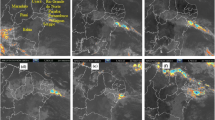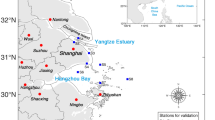Abstract
The remote influence of west Pacific typhoons on the historic Kerala flood in the 2018 Indian summer monsoon (ISM) season is investigated using the weather research and forecasting (WRF-ARW) model. The flood occurred as a result of vigorous monsoon intra-seasonal activity with some districts receiving excess rainfall exceeding 405%. Observational data reveals that a deflection of the monsoon low level jet (LLJ) occurred from south westerly to north westerly direction together with a slow-down of cloud movement over the central Kerala region due to a split in the LLJ core nearby the Arabian sea coast. The split and deflection of LLJ core produced cyclonic vorticity along 10° N latitude which favored severe convection. Nevertheless, a detailed analysis of the flow pattern reveals that the simultaneous formation of a low-pressure system (near Orissa coast in the Bay of Bengal) and several typhoons in the west-Pacific Ocean had a crucial role in the deflection and hence the production of cyclonic vorticity. By employing the tropical cyclone bogussing scheme in WRF-ARW, the formation of a west-Pacific typhoon was suppressed and subsequently a comparison was made against the control run in order to quantify the typhoon’s effect on the Kerala rainfall. It is found that the presence of low-latitude typhoon was primarily responsible for the deflection of the monsoon LLJ and hence the production of cyclonic vorticity through remote forcing. The study thus provides an insight into the teleconnection of west-Pacific typhoons on the intraseasonal variation of ISM and associated extreme rainfall events.





(Source: KITAMOTO Laboratory website http://agora.ex.nii.ac.jp/~kitamoto/)


(Source: KITAMOTO Laboratory website http://agora.ex.nii.ac.jp/~kitamoto/)

(Source: KITAMOTO Laboratory website http://agora.ex.nii.ac.jp/~kitamoto/)











Similar content being viewed by others
Data availability
The datasets analyzed during the current study are publicly available from: https://www.ecmwf.int/en/forecasts/datasets/reanalysis-datasets/era-interim; (URL: https://cds.climate.copernicus.eu/cdsapp#!/search?type=dataset). The NCEP/NCAR reanalysis data (2.5° × 2.5°) is available at: https://www.esrl.noaa.gov/psd/data/gridded/data.ncep.reanalysis.surface.html#detail. The ST Radar data of Cochin University of Science and Technology is available upon reasonable request due to Institute’s data sharing policy. Further, WRF Model output can be obtained from the Corresponding Author upon request.
References
Boos WR, Emanuel KE (2009) Annual intensification of the Somali jet in a quasi-equilibrium framework: observational composites. Quart J Royal Meteorol 135(639):319–335
Das S, Sarkar A, Das MK, Rahman MM, Islam MN (2015) Composite characteristics of Nor’westers based on observations and simulations. Atmos Res 158:158–178
Davidović D, Skala K (2010) Implementation of the WRF-ARW prognostic model on the Grid. In: The 33rd international convention MIPRO. IEEE, pp 220–225
ENVISC (ENVIS Centre) (2020) Kerala state of environmental and related issues. kerenvis.nic.in. - Kerala State Council for Science, Technology and Environment, kerenvis.nic.in/Database/ENVIRONMENT_821.aspx
Findlater J (1971) Mean monthly airflow at low levels over the Western Indian Ocean - Great Britain. Meteorological Office, H.M. Stationery Office
Gadgil S (2003) The Indian monsoon and its variability. Ann Rev Earth Planet Sci 31(1):429–467
GEER (2018) Geotechnical impacts of august 2018 floods of Kerala. Geotechnical Extreme Events Reconnaissance, India
Goswami BN, Venugopal V, Sengupta D, Madhusoodanan MS, Xavier PK (2006) Increasing trend of extreme rain events over India in a warming environment. Science 314(5804):1442–1445
Hsiao LF, Liou CS, Yeh TC, Guo YR, Chen DS, Huang KN, Terng C-T, Chen JH (2010) A vortex relocation scheme for tropical cyclone initialization in advanced research WRF. Mon Weather Rev 138(8):3298–3315
Hunt KM, Menon A (2020) The 2018 Kerala floods: a climate change perspective. Clim Dyn 54(3):2433–2446
IMD-India Meteorological Department (2018) Annual report—2018
IMD-India Meteorological Department (2019) IMD Regional report on southwest Monsoon—2018 over the southern peninsular India. Regional Meteorological Centre, Chennai
IPCC (Intergovernmental Panel on Climate Change) (2012) Managing the risks of extreme events and disasters to advance climate change adaptation. Cambridge University Press, Cambridge
Joseph PV, Raman PL (1966) Existence of low-level westerly jet stream over peninsular India during July. Mausam 17(3):407–410
Joseph PV, Sijikumar S (2004) Intraseasonal variability of the low-level jet stream of the Asian Summer Monsoon. J Clim 17:1449–1458
Krishnakumar KN, Rao GP, Gopakumar CS (2009) Rainfall trends in twentieth century over Kerala. India Atmos Environ 43(11):1940–1944
Kumar V, Krishnan R (2005) On the association between the Indian summer monsoon and the tropical cyclone activity over northwest Pacific. Curr Sci 25:602–612
Kumar V, Pradhan PK, Sinha T, Rao SVB, Chang HP (2020) Interaction of a low-pressure system, an offshore trough, and mid-tropospheric dry air intrusion: the Kerala flood of August 2018. Atmosphere 11(7):740
Low-Nam S, Davis C (2001) Development of a tropical cyclone bogussing scheme for the MM5 system. In: Preprints, 11th PSU–NCAR Mesoscale Model Users’ Workshop, Boulder, CO, PSU–NCAR 130:134
Mujumdar M, Kumar V, Krishnan R (2007) The Indian summer monsoon drought of 2002 and its linkage with tropical convective activity over northwest Pacific. Clim Dyn 28(7):743–758
Pai DS, Rajeevan M, Sreejith OP, Mukhopadhyay B, Satbha NS (2014) Development of a new high spatial resolution (0.25× 0.25) long period (1901-2010) daily gridded rainfall data set over India and its comparison with existing data sets over the region. Mausam 65(1):1–18
Pattanaik DR, Rajeevan M (2007) Northwest Pacific tropical cyclone activity and July rainfall over India. Meteorol Atmos Phys 95(1):63–72
Rajeevan M, Bhate J, Jaswal AK (2008) Analysis of variability and trends of extreme rainfall events over India using 104 years of gridded daily rainfall data. Geophys Res Lett 35(18)
Rajeevan M, Gadgil S, Bhate J (2010) Active and break spells of the Indian summer monsoon. J Earth Syst Sci 119(3):229–247
Raju A, Parekh A, Chowdary JS, Gnanaseelan C (2015) Assessment of the Indian summer monsoon in the WRF regional climate model. Clim Dyn 44(11):3077–3100
Ramanna GR (1969) Relationship between depressions of Bay of Bengal and tropical storms of the China Sea. Indian J Meteor Geophys 20:148–150
Roxy MK, Ghosh S, Pathak A, Athulya R, Mujumdar M, Murtugudde R, Terray P, Rajeevan M (2017) A threefold rise in widespread extreme rain events over central India. Nat Commun 8(1):1–11. https://doi.org/10.1038/s41467-017-00744-9
Samson TK, Kottayil A, Manoj MG, Binoy BB, Rakesh V, Rebello R, Vasudevan K, Mohanan P, Santosh KR, Mohankumar K (2016) Technical aspects of 205 MHz VHF mini wind profiler radar for tropospheric probing. IEEE Geosci Remote Sens Lett 13(7):1027–1031
Sandeep S, Ajayamohan RS (2015) Poleward shift in Indian summer monsoon low level jetstream under global warming. Clim Dyn 45(1):337–351
Sengupta D, Goswami BN, Senan R (2001) Coherent intraseasonal oscillations of ocean and atmosphere during the Asian summer monsoon. Geophys Res Lett 28(21):4127–4130
Sreenath AV, Abhilash S, Vijaykumar P (2021) Variability in lightning hazard over Indian region with respect to El Niño-Southern Oscillation (ENSO) phases. Nat Hazard 21(8):2597–2609
Sudheer KP, Bhallamudi SM, Narasimhan B, Thomas J, Bindhu VM, Vema V, Kurian C (2019) Role of dams on the floods of August 2018 in Periyar River Basin. Kerala. Current Science 116(5):00113891
Wilson SS, Joseph PV, Mohanakumar K, Johannessen OM (2018) Interannual and long term variability of low level jet stream of the Asian summer monsoon. Tellus a: Dyn Meteorol Oceanogr 70(1):1–9
Xavier A, Kottayil A, Mohanakumar K, Xavier PK (2018) The role of monsoon low-level jet in modulating heavy rainfall events. Int J Climatol 38:e569–e576
Acknowledgements
The authors are thankful to the Director, ACARR for the encouragements and support. The data from IMD, NCEP/NCAR and ERA reanalysis schemes are acknowledged. The authors also acknowledge the WRF Model developed by NCAR.
Funding
The authors declare that no funds, grants, or other support were received during the preparation of this manuscript.
Author information
Authors and Affiliations
Contributions
The conception and design of the study was done by MGM. Material preparation, data collection and analysis were performed by PPM and MGM. The first draft of the manuscript was prepared by PPM and MGM, and all authors commented on previous versions of the manuscript. All authors read and approved the final manuscript.
Corresponding author
Ethics declarations
Conflict of interest
The authors have no relevant financial or non-financial interests to disclose.
Additional information
Publisher's Note
Springer Nature remains neutral with regard to jurisdictional claims in published maps and institutional affiliations.
Supplementary Information
Below is the link to the electronic supplementary material.
Rights and permissions
Springer Nature or its licensor (e.g. a society or other partner) holds exclusive rights to this article under a publishing agreement with the author(s) or other rightsholder(s); author self-archiving of the accepted manuscript version of this article is solely governed by the terms of such publishing agreement and applicable law.
About this article
Cite this article
Musaid, P.P., Manoj, M.G., Panda, S.K. et al. Dynamical influence of West Pacific Typhoons on the 2018 historic flood of Kerala as revealed by the weather research and forecasting (WRF) model. Clim Dyn 61, 1663–1681 (2023). https://doi.org/10.1007/s00382-022-06648-9
Received:
Accepted:
Published:
Issue Date:
DOI: https://doi.org/10.1007/s00382-022-06648-9




